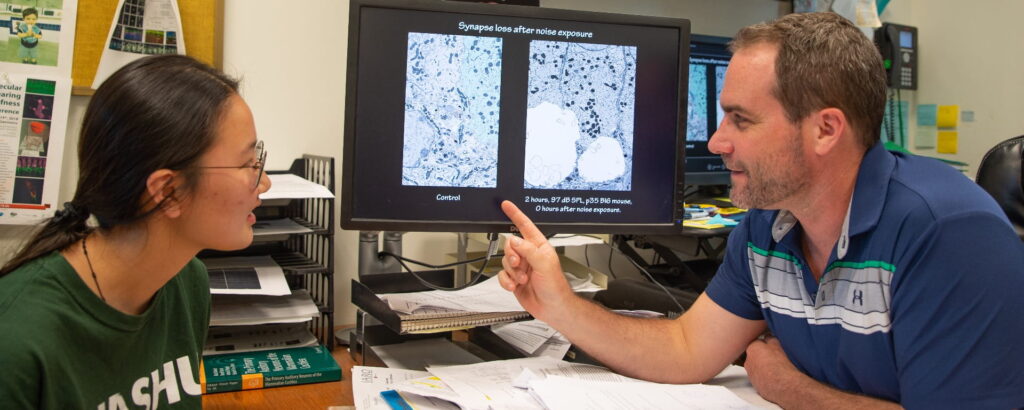Washington University undergraduate Heather Chung works with Mark Rutherford, PhD, to test synapse loss.
The Rutherford lab studies the smallest parts of the ear called synapses. Synapses are the sites of communication between two neurons or between a neuron and a sensory receptor cell. New biological imaging techniques have made these structures much easier to observe.
Mark Rutherford, PhDAccording to Mark Rutherford, PhD, assistant professor in the Department of Otolaryngology, “All information about your acoustic environment is carried to the brain by auditory nerve fibers. These fibers are stimulated by a chemical neurotransmitter called glutamate that is released from sensory hair cells in the inner ear.”
Too much glutamate causes over-excitation and can be toxic to nerve cells. This process, called excitotoxicity, can lead to neurodegeneration and hearing loss. It is the goal of the Rutherford lab to better understand the actions of glutamate at the synapse and determine what properties create synapses that are more vulnerable to excitoxic damage.
The lab is currently studying the composition of glutamate receptors to assess vulnerability. Each receptor is made of four pieces, called subunits.
The Rutherford Lab relies on the talents of everyone on the team to tackle hearing loss research including Shelby Pane, senior research technician.“We are testing the idea that some subunit combinations are more vulnerable to damage and others are protective,” said Rutherford. This approach has been applied to two new NIH-funded projects currently underway.
The first study is looking at sex differences in susceptibility to hearing loss, with collaborator Maria Rubio, PhD, at University of Pittsburgh. By comparing noise induced synapse damage in females and males with different combinations of glutamate receptor subunits, they hope to decipher the interplay of sex hormones and glutamate receptors in auditory sensitivity and vulnerability.
The second study is looking at synaptic pathology in aging, particularly Alzheimer’s patients, in collaboration with John Cirrito and Carla Yuede in the Department of Neurology at Washington University. The lab hopes to identify evidence of glutamate receptor misregulation that might explain both auditory dysfunction and cognitive decline seen in these patients.
“We hope this work will lead to early diagnostics for the development of dementia, or to therapies for neurodegenerative hearing loss,” said Rutherford.
